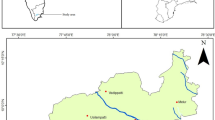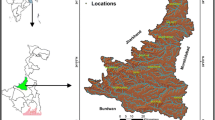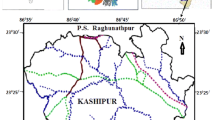Abstract
Identification of groundwater recharge zones in an area is important to properly utilize and safeguard the groundwater resources. The objective of this study is to delineate the groundwater potential zones in the Chinnar River basin of Perambalur district, southern India, using remote sensing and GIS methods. Toposheets and satellite imageries were used to prepare various thematic maps such as geology, soil, drainage density, slope, lineament density, geomorphology, and land use. These data were combined with the weighted overlay method to demarcate the groundwater potential zones. Multi-influencing factor (MIF) method was used to derive the weights for the seven layers, and ranks were assigned to the features within the layers based on local knowledge and from literature. The study suggests that the geology, slope, land use, and geomorphology features play a major role in determining the availability of groundwater in the study area. The groundwater potential was high in 54%, medium in 21%, and low in 25% of the study area. The groundwater level fluctuation that varies based on the rainfall and different rock types was used to validate the groundwater potential map. Areas with high groundwater potential had the lowest groundwater fluctuation compared with the medium and low groundwater potential areas. Sensitivity analysis showed that excluding the land use and geomorphology features will have the highest impact on identifying the groundwater potential zones. Determination of effective weights indicated that land use, geomorphology, and slope have higher weights than the assigned weights. The results show that the delineated groundwater potential zones can be used in the future for groundwater resource management in the study area.







Similar content being viewed by others
References
Ahamed AJ, Ananthakrishnan S, Loganathan K, Manikandan K (2013) Assessment of groundwater quality for irrigation use in Alathur Block, Perambalur District, Tamilnadu, South India. Appl Water Sci 3:763–771. https://doi.org/10.1007/s13201-013-0124-z
Anbarasu S, Elango L (2016) Assessment of groundwater quality in a part of Chinnar watershed, Perambalur District, Tamilnadu, India. International Journal of Earth Sciences and Engineering 9:2466–2471
Anbazhagan S, Jothibasu A (2016) Geoinformatics in groundwater potential mapping and sustainable development: a case study from southern India. Hydrol Sci J 61:1109–1123. https://doi.org/10.1080/02626667.2014.990966
Andualem TG, Demeke GG (2019) Groundwater potential assessment using GIS and remote sensing: a case study of Guna tana landscape, upper blue Nile Basin. Ethiopia Journal of Hydrology: Regional Studies 24:100610. https://doi.org/10.1016/j.ejrh.2019.100610
Aouragh MH, Essahlaoui A, El Ouali A, El Hmaidi A, Kamel S (2017) Groundwater potential of Middle Atlas plateaus, Morocco, using fuzzy logic approach, GIS and remote sensing. Geomatics, Natural Hazards and Risk 8:194–206. https://doi.org/10.1080/19475705.2016.1181676
Arabameri A, Rezaei K, Cerda A, Lombardo L, Rodrigo-Comino J (2019) GIS-based groundwater potential mapping in Shahroud plain, Iran. A comparison among statistical (bivariate and multivariate), data mining and MCDM approaches. Sci Total Environ 658:160–177. https://doi.org/10.1016/j.scitotenv.2018.12.115
Avtar R, Singh CK, Shashtri S, Singh A, Mukherjee S (2010) Identification and analysis of groundwater potential zones in Ken–Betwa river linking area using remote sensing and geographic information system. Geocarto International 25:379–396. https://doi.org/10.1080/10106041003731318
Babiker IS, Mohamed MA, Hiyama T, Kato K (2005) A GIS-based DRASTIC model for assessing aquifer vulnerability in Kakamigahara Heights, Gifu Prefecture, central Japan. Sci Total Environ 345:127–140. https://doi.org/10.1016/j.scitotenv.2004.11.005
CGWB (2009) District Ground Water Brochure, Perambalur District, Tamil Nadu. Central Ground Water Board, Ministry of Water Resources, Government of India, Faridabad
CGWB (2011) Dynamic Ground Water Resources of India- 2009. Central Ground Water Board, Ministry of Water Resources, Government of India, Faridabad
CGWB (2017) Groundwater Year book of Tamil Nadu and U.T. of Puducherry. Central Ground Water Board, Ministry of Water Resources, River Development & Ganga Rejuvenation, Government of India, Faridabad
Chaudhary BS, Kumar S (2018) Identification of groundwater potential zones using remote sensing and GIS of K-J Watershed, India. J Geol Soc India 91:717–721. https://doi.org/10.1007/s12594-018-0929-3
Cui K, Lu D, Li W (2017) Comparison of landslide susceptibility mapping based on statistical index, certainty factors, weights of evidence and evidential belief function models. Geocarto International 32:935–955. https://doi.org/10.1080/10106049.2016.1195886
Das N, Mukhopadhyay S (2018) Application of multi-criteria decision making technique for the assessment of groundwater potential zones: a study on Birbhum district, West Bengal, India. Environ Dev Sustain. https://doi.org/10.1007/s10668-018-0227-7
Etikala B, Golla V, Li P, Renati S (2019) Deciphering groundwater potential zones using MIF technique and GIS: a study from Tirupati area, Chittoor District, Andhra Pradesh, India. HydroResearch 1:1–7. https://doi.org/10.1016/j.hydres.2019.04.001
Fagbohun BJ (2018) Integrating GIS and multi-influencing factor technique for delineation of potential groundwater recharge zones in parts of Ilesha schist belt, southwestern Nigeria. Environ Earth Sci 77. https://doi.org/10.1007/s12665-018-7229-5
Falah F, Ghorbani Nejad S, Rahmati O, Daneshfar M, Zeinivand H (2017) Applicability of generalized additive model in groundwater potential modelling and comparison its performance by bivariate statistical methods. Geocarto International 32:1069–1089. https://doi.org/10.1080/10106049.2016.1188166
GEC (2017) Report of the Ground Water Resource Estimation Committee- GEC 2015. Ministry of Water Resources, River Development & Ganga Rejuvenation, Government of India, Faridabad
Ghorbani Nejad S, Falah F, Daneshfar M, Haghizadeh A, Rahmati O (2017) Delineation of groundwater potential zones using remote sensing and GIS-based data-driven models. Geocarto International 32:167–187. https://doi.org/10.1080/10106049.2015.1132481
Gnanachandrasamy G, Zhou Y, Bagyaraj M, Venkatramanan S, Ramkumar T, Wang S (2018) Remote sensing and GIS based groundwater potential zone mapping in Ariyalur District, Tamil Nadu. J Geol Soc India 92:484–490. https://doi.org/10.1007/s12594-018-1046-z
GSI (1995) Geology map of Perambalur district, Tamil Nadu. Geological Survey of India, Government of India, Faridabad
Jasmin I, Mallikarjuna P (2011) Review: Satellite-based remote sensing and geographic information systems and their application in the assessment of groundwater potential, with particular reference to India. Hydrogeol J 19:729–740
Jha MK, Chowdary VM, Chowdhury A (2010) Groundwater assessment in Salboni Block, West Bengal (India) using remote sensing, geographical information system and multi-criteria decision analysis techniques. Hydrogeol J 18:1713–1728. https://doi.org/10.1007/s10040-010-0631-z
Jha MK, Chowdhury A, Chowdary VM, Peiffer S (2006) Groundwater management and development by integrated remote sensing and geographic information systems: prospects and constraints. Water Resour Manag 21:427–467. https://doi.org/10.1007/s11269-006-9024-4
Lee S, Hong S-M, Jung H-S (2018) GIS-based groundwater potential mapping using artificial neural network and support vector machine models: the case of Boryeong city in Korea. Geocarto International 33:847–861. https://doi.org/10.1080/10106049.2017.1303091
Lee S, Kim Y-S, Oh H-J (2012) Application of a weights-of-evidence method and GIS to regional groundwater productivity potential mapping. J Environ Manag 96:91–105. https://doi.org/10.1016/j.jenvman.2011.09.016
Lodwick WA, Monson W, Svoboda L (1990) Attribute error and sensitivity analysis of map operations in geographical information systems: suitability analysis. Int J Geogr Inf Sci 4:413–428
Machiwal D, Jha MK, Mal BC (2011) Assessment of groundwater potential in a semi-arid region of India using remote sensing, GIS and MCDM techniques. Water Resour Manag 25:1359–1386. https://doi.org/10.1007/s11269-010-9749-y
Mahato S, Pal S (2018) Groundwater potential mapping in a rural river basin by union (OR) and intersection (AND) of four multi-criteria decision-making models. Nat Resour Res 28:523–545. https://doi.org/10.1007/s11053-018-9404-5
Ministry of Environment Forest and Climate Change (2018) District survey report for roughstone. Perambalur district, Tamilnadu state
Misi A, Gumindoga W, Hoko Z (2018) An assessment of groundwater potential and vulnerability in the Upper Manyame Sub-Catchment of Zimbabwe. Physics and Chemistry of the Earth, Parts A/B/C 105:72–83. https://doi.org/10.1016/j.pce.2018.03.003
Mogaji KA, Omosuyi GO, Adelusi AO, Lim HS (2016) Application of GIS-based evidential belief function model to regional groundwater recharge potential zones mapping in hardrock geologic terrain. Environmental Processes 3:93–123. https://doi.org/10.1007/s40710-016-0126-6
Mohamed MM, Elmahdy SI (2017) Fuzzy logic and multi-criteria methods for groundwater potentiality mapping at Al Fo’ah area, the United Arab Emirates (UAE): an integrated approach. Geocarto International 32:1120–1138. https://doi.org/10.1080/10106049.2016.1195884
Mokadem N, Boughariou E, Mudarra M, Ben Brahim F, Andreo B, Hamed Y, Bouri S (2018) Mapping potential zones for groundwater recharge and its evaluation in arid environments using a GIS approach: case study of North Gafsa Basin (Central Tunisia). J Afr Earth Sci 141:107–117. https://doi.org/10.1016/j.jafrearsci
Murmu P, Kumar M, Lal D, Sonker I, Singh SK (2019) Delineation of groundwater potential zones using geospatial techniques and analytical hierarchy process in Dumka district, Jharkhand, India. Groundw Sustain Dev 9:100239. https://doi.org/10.1016/j.gsd.2019.100239
Napolitano P, Fabbri AG (1996) Single-parameter sensitivity analysis for aquifer vulnerability assessment using DRASTIC and SINTACS. Paper presented at the HydroGIS 96: Application of Geographic Information Systems in Hydrology and Water Resources Management (Proceedings of the Vienna Conference, April 1996), IAHS Publ. No. 235
Oh H-J, Kim Y-S, Choi J-K, Park E, Lee S (2011) GIS mapping of regional probabilistic groundwater potential in the area of Pohang City, Korea. J Hydrol 399:158–172. https://doi.org/10.1016/j.jhydrol.2010.12.027
Oladunjoye MA, Adefehinti A, Ganiyu KAO (2019) Geophysical appraisal of groundwater potential in the crystalline rock of Kishi area, Southwestern Nigeria. J Afr Earth Sci 151:107–120. https://doi.org/10.1016/j.jafrearsci.2018.11.017
Patra S, Mishra P, Mahapatra SC (2018) Delineation of groundwater potential zone for sustainable development: a case study from Ganga Alluvial Plain covering Hooghly district of India using remote sensing, geographic information system and analytic hierarchy process. J Clean Prod 172:2485–2502. https://doi.org/10.1016/j.jclepro.2017.11.161
Pham BT, Jaafari A, Prakash I, Singh SK, Quoc NK, Bui DT (2019) Hybrid computational intelligence models for groundwater potential mapping CATENA 182:104101 doi: https://doi.org/10.1016/j.catena.2019.104101
Pourghasemi HR, Beheshtirad M (2015) Assessment of a data-driven evidential belief function model and GIS for groundwater potential mapping in the Koohrang Watershed, Iran. Geocarto International 30:662–685. https://doi.org/10.1080/10106049.2014.966161
Pradhan B (2009) Groundwater potential zonation for basaltic watersheds using satellite remote sensing data and GIS techniques. Central European Journal of Geosciences 1:120–129. https://doi.org/10.2478/v10085-009-0008-5
Preeja KR, Joseph S, Thomas J, Vijith H (2011) Identification of groundwater potential zones of a tropical river basin (Kerala, India) using remote sensing and GIS techniques. Journal of the Indian Society of Remote Sensing 39:83–94. https://doi.org/10.1007/s12524-011-0075-5
Rajaveni SP, Brindha K, Elango L (2015) Geological and geomorphological controls on groundwater occurrence in a hard rock region. Appl Water Sci 7:1377–1389. https://doi.org/10.1007/s13201-015-0327-6
Razandi Y, Pourghasemi HR, Neisani NS, Rahmati O (2015) Application of analytical hierarchy process, frequency ratio, and certainty factor models for groundwater potential mapping using GIS. Earth Sci Inf 8:867–883. https://doi.org/10.1007/s12145-015-0220-8
Senanayake IP, Dissanayake DMDOK, Mayadunna BB, Weerasekera WL (2016) An approach to delineate groundwater recharge potential sites in Ambalantota, Sri Lanka using GIS techniques. Geosci Front 7:115–124. https://doi.org/10.1016/j.gsf.2015.03.002
Sener E, Davraz A, Ozcelik M (2004) An integration of GIS and remote sensing in groundwater investigations: a case study in Burdur, Turkey. Hydrogeol J 13:826–834. https://doi.org/10.1007/s10040-004-0378-5
Suganthi S, Elango L, Subramanian SK (2014) Groundwater potential zonation by remote sensing and GIS techniques and its relation to the groundwater level in the coastal part of the Arani and Koratalai River Basin, Southern India. Earth Sciences Research Journal 17:87–95
Survey of India (1995) Topographic map of Perambalur district, Tamil Nadu
TWAD (2018) Perambalur District Profile, Tamil Nadu Water Supply and Drainage Board, Available from https://www.twadboard.tn.gov.in/content/perambalur-district, accessed on 5th August 2019
Acknowledgments
We thank the Central Ground Water Board, Chennai, and the Public Works Department, Chennai, for providing the data.
Funding
The authors would like to thank the University Grants Commission, New Delhi, for the financial support for this work (F 17-68/2008 (SA-1)).
Author information
Authors and Affiliations
Corresponding author
Additional information
Communicated by: H. Babaie
Publisher’s note
Springer Nature remains neutral with regard to jurisdictional claims in published maps and institutional affiliations.
Rights and permissions
About this article
Cite this article
Anbarasu, S., Brindha, K. & Elango, L. Multi-influencing factor method for delineation of groundwater potential zones using remote sensing and GIS techniques in the western part of Perambalur district, southern India. Earth Sci Inform 13, 317–332 (2020). https://doi.org/10.1007/s12145-019-00426-8
Received:
Accepted:
Published:
Issue Date:
DOI: https://doi.org/10.1007/s12145-019-00426-8




